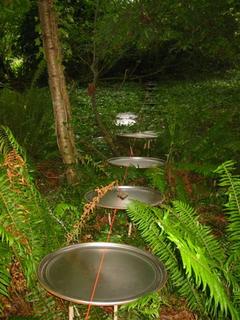Publicity in Seattle Times
This article was printed in the Friday, September 9, 2005 Ticket section of the Seattle Times and can be found online at http://archives.seattletimes.nwsource.com/cgi-bin/texis.cgi/web/vortex/display?slug=visarts09&date=20050909&query=collocation
A Bainbridge park as archaeological tour
Special to the Seattle Times
A wedge of Scotch broom that Gregory Glynn has cut by hand lies in the middle of a swath where he has cleared, then gathered and compressed the invasive plant. Situated in a clearing with spectacular views, Glynn's "Foundation" is wavy and organic at the top where branches have dried up, neat as a slice where the cut ends face. "Foundation's" dual nature reflects both the beauty and problems addressed by "Collocation," an exhibit in Bainbridge Island's Pritchard Park.
Pritchard Park is a 50-acre area with beach access, forests and panoramic views. Formerly a dwelling area for Native Americans and then an industrial site with worker housing, it was closed because of contamination. Cleanup is nearly complete, and the park opened again just last year, except for a few areas.
A trust has bought half the park and is raising funds to buy the entire site, with a portion allocated as a memorial for Japanese-American internees. According to exhibit curator Kristin Tollefson, "within Pritchard Park we see co-existences of lush growth and decay, and we know of a complicated and painful history coupled with insurgent hope for future use."
"Collocation" dusk to dawn daily through Sept. 24, Pritchard Park, Bainbridge Island (www.artshum.org/community/pubart/pritchard).
Going through the exhibit is refreshingly not like viewing art in a gallery, but a kind of archaeological exercise as art gets revealed at the end of trails. Pieces exist in subtle juxtaposition with vegetation, terrain or the remains of dwellings. Artifacts left from previous use lie alongside art, enigmatic in and of themselves: a fire hydrant, a porcelain toilet, a gatepost.
In Melanie Noel's "ghostrain," white paper foldouts printed with fragments of a poem act like signposts for a journey. They are hung throughout the park under the shadows of trees, inside the wreck of a car, along a chain-link fence surrounding a still-contaminated area. Unfortunately, the ones hanging along the fence had been set on fire, an act of vandalism that sadly took advantage of the piece's vulnerability.
Interspersed with discarded roof shingles are Polly Purvis' photo paper printouts of dance figures. Looking like angels dancing on a mound, there's an otherworldly quality to this piece. By infusing discards with art, Purvis counteracts our culture's impulse to throw things away and instead creates sacred space.
Participation with place inevitably includes deterioration, but often this process imparts an unexpected sense of beauty. The firm of rbf architecture simulates this concept in "align," a row of oil-drum lids on the forest floor. Swirls of orange rust pop visually against green vegetation. Impeccably queued, they follow a slope that leads to a cliff, as if undertaking an eternal march.
Diana Liljelund and Perri Lynch book-end the show with pieces that also make the most visual impact. Liljelund's "The Immigrant" is a madrona tree from inland that had died and was transported and painted lacquer red. Looking like an artery drawing blood from the sky, the piece is bold but emotionally unsettling.
Lynch's piece is the most ambitious in scale and concept, rigorous and wonderfully successful. Sited on the beach area, Lynch's grid of industrial-height plastic tubes resonates with the verticality of the forest and with the masts of boats in the nearby marina. Topped with white flags, the regimented poles echo gravestones and reflect a sense of loss. On the gravel foundation, briar flowers offer a token of grace. Wander amid this forest of tubes and listen to the wind blowing through — an artistic cry for balance longs to be heard.



